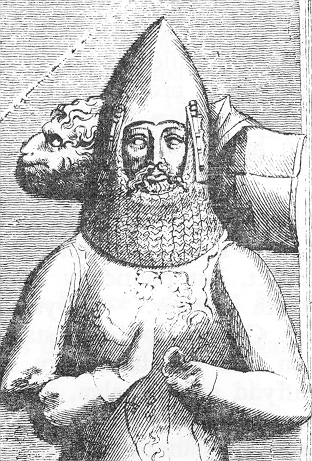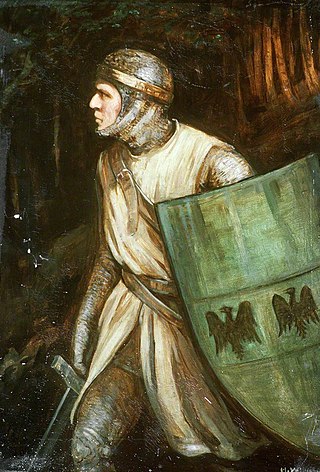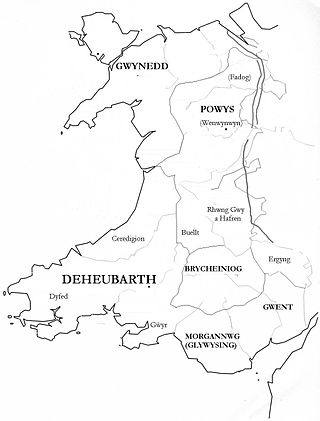Related Research Articles

Rhys ap Gruffydd or ap Gruffudd was the ruler of the kingdom of Deheubarth in south Wales from 1155 to 1197. Today, he is commonly known as The Lord Rhys, in Welsh Yr Arglwydd Rhys, although this title may have not been used in his lifetime. He usually used the title "Proprietary Prince of Deheubarth" or "Prince of South Wales", but two documents have been discovered in which he uses the title "Prince of Wales" or "Prince of the Welsh". Rhys was one of the most successful and powerful Welsh princes, and, after the death of Owain Gwynedd of Gwynedd in 1170, the dominant power in Wales.

Owain ap Gruffudd was King of Gwynedd, North Wales, from 1137 until his death in 1170, succeeding his father Gruffudd ap Cynan. He was called Owain the Great and the first to be styled "Prince of Wales" and the "Prince of the Welsh". He is considered to be the most successful of all the North Welsh princes prior to his grandson, Llywelyn ab Iorwerth. He became known as Owain Gwynedd to distinguish him from the contemporary king of Powys Wenwynwyn, Owain ap Gruffydd ap Maredudd, who became known as Owain Cyfeiliog.
Gruffydd ap Llywelyn was the first and only Welsh king to unite all of Wales under his rule from 1055 to 1063. He had also previously been King of Gwynedd and Powys from 1039 to 1055. Gruffydd was the son of Llywelyn ap Seisyll, king of Gwynedd, and Angharad daughter of Maredudd ab Owain, king of Deheubarth, and the great-great-grandson of Hywel Dda. After his death, Wales was again divided into separate kingdoms.

Gruffudd ap Cynan was King of Gwynedd from 1081 until his death in 1137. In the course of a long and eventful life, he became a key figure in Welsh resistance to Norman rule.

The Kingdom of Gwynedd was a Welsh kingdom and a Roman Empire successor state that emerged in sub-Roman Britain in the 5th century during the Anglo-Saxon settlement of Britain.

The Kingdom of Powys was a Welsh successor state, petty kingdom and principality that emerged during the Middle Ages following the end of Roman rule in Britain. It very roughly covered the northern two-thirds of the modern county of Powys and part of today's English West Midlands. More precisely, and based on the Romano-British tribal lands of the Ordovices in the west and the Cornovii in the east, its boundaries originally extended from the Cambrian Mountains in the west to include the modern West Midlands region of England in the east. The fertile river valleys of the Severn and Tern are found there, and this region is referred to in later Welsh literature as "the Paradise of Powys".

Rhys ap Tewdwr was a king of Deheubarth in Wales and member of the Dinefwr dynasty, a branch descended from Rhodri the Great. Following the Norman Conquest, he had to pay William the Conqueror to keep his kingdom, which lasted until the end of William's reign.
Owain Goch ap Gruffudd was brother to Llywelyn ap Gruffudd and Dafydd ap Gruffudd and, for a brief period in the late 1240s and early 1250s, ruler of part of the Kingdom of Gwynedd.
Hywel ab Owain Gwynedd, King of Gwynedd in 1170, was a Welsh poet and military leader. Hywel was the son of Owain Gwynedd, king of Gwynedd and an Irishwoman named Pyfog. In recognition of this, he was also known as Hywel ap Gwyddeles. Hywel is also known as the Poet Prince for his bardic skills.
Trahaearn ap Caradog (1044–1081) was a King of Gwynedd. Trahaearn was a son of Caradog ap Gwyn, ruler of Arwystli, a small state, on the south-western border between Gwynedd and Powys. He was born in 1044 in Arwystli, and died in 1081 in Mynydd Carn in Pembrokeshire, at the Battle of Mynydd Carn.
Caradog ap Gruffydd was a Prince of Gwent in south-east Wales in the time of Gruffydd ap Llywelyn and the Norman conquest, who reunified his family's inheritance of Morgannwg and made repeated attempts to reunite southern Wales by claiming the inheritance of the Kingdom of Deheubarth.
Cadwaladr ap Gruffydd was the third son of Gruffudd ap Cynan, King of Gwynedd, and brother of Owain Gwynedd.

Maredudd ap Bleddyn was a prince and later King of Powys in eastern Wales. He was involved in the rebellions against Henry I of England, son of William the Conqueror, who launched the Norman invasion of Wales. He was featured in the Brut y Tywysogion, and was succeeded by his son, Prince Madog ap Maredudd.
Maredudd ap Cynan was the grandson of Owain Gwynedd, a king of Gwynedd and ruler of most of Wales in the 12th century. His father Cynan ab Owain Gwynedd held the title "Lord of Meirionnydd".
This article is about the particular significance of the century 1101–1200 to Wales and its people.
This article is about the particular significance of the century 1001–1100 to Wales and its people.

The history of Gwynedd in the High Middle Ages is a period in the history of Wales spanning the 11th to the 13th centuries. Gwynedd, located in the north of Wales, eventually became the most dominant of Welsh polities during this period. Contact with continental courts allowed for Gwynedd to transition from a petty kingdom into an increasingly sophisticated principality of seasoned courtiers capable of high-level diplomacy and representation, not only with the Angevin kings of England, but with the king of France and the Papacy. Distinctive achievements in Gwynedd include the further development of medieval Welsh literature, particularly the work of the princely court poets known as Beirdd y Tywysogion and the reformation of bardic schools; and the continued development of Cyfraith Hywel. All three of these further contributed to the development of a Welsh national identity in the face of Anglo-Norman encroachment on Wales.
Owain ab Edwin of Tegeingl or Owain the Traitor, was lord of the cantref of Tegeingl in north-east Wales at the end of the 11th century. He was the son of Edwin ap Gronw of Tegeingl, a great-great-grandson of Hywel Dda. He sided with the Normans in their failed invasion of North Wales, and in the 1090s attempted to become ruler of Gwynedd.
References
- ↑ Pryce, Huw (2010). The Acts of Welsh Rulers, 1120-1283. University of Wales Press. pp. 25–26. ISBN 978-0-7083-2387-8.